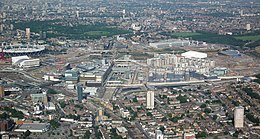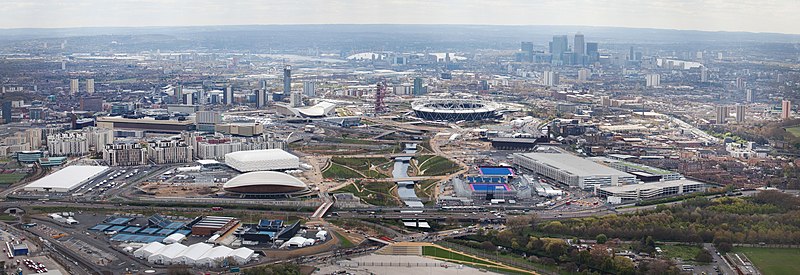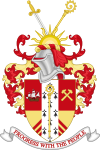East Village, London: Difference between revisions
→Design: Arup |
→Design: urban planning and landscape architecture firm |
||
| Line 33: | Line 33: | ||
==Design== |
==Design== |
||
Lend Lease engaged architects Fletcher Priest |
Lend Lease engaged a team of: architects Fletcher Priest; structural engineers [[Arup]]; and [[urban planning]]/[[landscape architecture]] firm [[West 8]]. They were briefed to design a village-garden type district to fit in with the wider [[urban park]] vision of the Olympic Park legacy, emulating the classical [[Victorian architecture]] layout of [[Maida Vale]] and other parts of Victorian west London.<ref name=ObsRev>{{cite web|url=http://www.guardian.co.uk/artanddesign/2012/jan/08/athletes-village-olympics-2012-architecture|title=Olympic Village – review|author=Rowan Moore|publisher=[[The Observer]]|date=8 January 2012|accessdate=27 July 2012}}</ref> |
||
On a {{convert|27|ha}} site,<ref name=eArch/> the plan provided for 11 residential plots, each made up of 5 to 7 blocks, built around communal squares and courtyards, with water features accentuating the closeness of the [[River Lea]].<ref name=ObsRev/> |
On a {{convert|27|ha}} site,<ref name=eArch/> the plan provided for 11 residential plots, each made up of 5 to 7 blocks, built around communal squares and courtyards, with water features accentuating the closeness of the [[River Lea]].<ref name=ObsRev/> |
||
Revision as of 12:53, 28 July 2012
| East Village | |
|---|---|
 Olympic and Paralympic Village, April 2012. To the rear is the temporary Basketball Arena | |
| OS grid reference | TQ385845 |
| • Charing Cross | 6 mi (9.7 km) WSW |
| London borough | |
| Ceremonial county | Greater London |
| Region | |
| Country | England |
| Sovereign state | United Kingdom |
| Post town | LONDON |
| Postcode district | E20 |
| Dialling code | 020 |
| Police | Metropolitan |
| Fire | London |
| Ambulance | London |
| UK Parliament | |
| London Assembly | |





East Village is a district of Stratford in East London, which was constructed as part of the 2012 Summer Olympics. Designed and built as the Olympic Village, after the games it will be converted into the new district of East Village.
Project background
As part of the regeneration programme within the bid for the 2012 Summer Olympics, the Olympic Village design that will house the athletes was based in reusing the buildings after the games as a new residential district for Stratford.
Through a competetive bidding process, the then Labour British government choose a proposal by Lend Lease Project Management & Construction, formerly Bovis plc now a division of Lend Lease Corporation of Australia, which covered financing and construction of both the Olympic Village and part of the London Olympics Media Centre. This would provide both accomodation for 24,000 athletes, and afterwards provide a mix of low cost and private residential housing, within a community that would comprise offices, shops, schools and a health centre.
Design
Lend Lease engaged a team of: architects Fletcher Priest; structural engineers Arup; and urban planning/landscape architecture firm West 8. They were briefed to design a village-garden type district to fit in with the wider urban park vision of the Olympic Park legacy, emulating the classical Victorian architecture layout of Maida Vale and other parts of Victorian west London.[1]
On a 27 hectares (67 acres) site,[2] the plan provided for 11 residential plots, each made up of 5 to 7 blocks, built around communal squares and courtyards, with water features accentuating the closeness of the River Lea.[1]
Each of the 67 blocks is of between 8 and 12 storeys high, nominally laid out:[1]
- Street level: mostly three storey townhouses, with front doors on street level to create an "active frontage".[1] These are supplemented by a mix of single to three storey shops and offices.[1]
- Floor 3 and above: in the centre of the complex are communal raised gardens, which hide carparks beneath.[1] At and above this level are a mix of low cost and private residential apartments, ranging from one to five bedroom. Each apartment provides generous floor spacing, and each includes its own balcony that is big enough for a table and chairs.[1]
The wider community is planned with wide vistas filled with gardens, parks and communal areas, within which are to be housed a school, a health clinic and shops.[1]
Development
The whole Olympic Park site was proposed to be secured under a Compulsory Purchase Order (CPO) by the London Development Agency. In late 2005, a row broke out between then Mayor of London Ken Livingstone and Newham Council/Westfield Group over the use of the legal instrument. The site for the Olympic Village was to be located next to the £4Bn development of Stratford City, but access difficulties meant that the Olympic Park CPO extended onto the site for Stratford City. In November 2005, an agreement was made where by the CPO over the Westfield site was removed, subject to agreed access provisions to the Olympic Village.[3]
In light of the 2008 financial crisis, Lend Lease found difficulties in raising funds for the construction of the village on the commercial markets, the single largest project in the 2012 Summer Olympic scheme.[4] The government via the Olympic Delivery Authority (ODA) hence agreed to underwrite a greater part of the required sum, and a scale-back of the project scale by 25%, on the proviso that athletes competing in non-London based events would be housed locally to their competition.[5] Following the athletes' experiences in Beijing 2008, and in particular through comments concerning athletes' welfare by International Olympic Committee President Jacques Rogge, this compromise was to be reconsidered whilst pressure built for the finance deal to be resolved.[6]
Demolition/site clearance
Up until this point, the proposed site had been a mix of former industrial buildings and contaminated land. The proposed site for the village provided two living camp sites for Irish Travellers, one on Clays Lane, Newham, and a second on Waterden Crescent, Hackney. The final part of the Olympic CPO covering the village site, secured in December 2006, was unsuccessfully challenged by the travellers in the High Court in May 2007.[7]
Towards the end of demolition/site clearance, in November 2007 a fire broke out in an old warehouse on Waterden Road, Hackney Wick, on the western-edge of the proposed village site. With flames of 50 feet (15 m) in height engulfing the building and sending clouds of acrid black smoke over the city centre, it took 75 firefighters from the London Fire Brigade to bring the fire under control.[8]
Construction
Construction of the village began in May 2008, following planning approval for the first blocks by Newham Council. However, having secured half of the required £1Bn private funding package, Lend Lease suffered further financing problems,[9] and was provided in October 2008 with part of a £95 million fund released by the British Government from the £2Bn 2012 Summer Olympics contingency fund.[10] Lend Lease then proposed a Private Finance Initiative, eventually coming back in late 2008 with a new financing proposal of up to £150m in equity and £225m in bank debts to finance construction. Whilst cosidering the proposal, then Olympics Minister Tessa Jowell agreed to provide monies from the contingency fund, including £326 million towards the village and £135 million towards the media centre.[11] In April 2009, the European Investment Bank offered to part finance the PFI via the ODA, with a £225 million loan.[12]
In May 2009 Olympics Minister Jowell finally rejected the Lend Lease deal. Taking the Olympic Village project under public ownership, Jowell by provided a further £329 million in additional direct government expenditure, sourced by combing an additional £261m from the contingency fund and £63m from savings elsewhere in the Olympic project.[13] Lend Lease would act as project managers for the village construction, but only be left with ownership of the media centre post the Olympics. Jowell also announced an agreement with Triathlon Homes, who bought and will manage the affordable homes in a separate £268 million agreement.[13] Construction ended in mid-2012, with total site development costing £1.1Bn.[14]
Olympic and Paralympic village
For summer 2012, the first use for the blocks will be as the Olympic Village for the 2012 Summer Olympics. Taking the original design, the architects added temporary partitioning to create "hotel" style apartments catering for:[1]
- 3,300 apartments: each will have a TV, internet access, and a private courtyard
- 17,320 beds: providing each athlete with 16 square metres (170 sq ft) floor space
In addition, the developers added two temporary buildings:
- Food hall: a 17,000 square metres (180,000 sq ft) food hall, which is open 24 hours a day, capable of catering for 5,500 athletes at a time
- Entertainment hall: 10,000 square metres (110,000 sq ft) entertainment area, providing games and communcal rest space, plus a non-alcoholic bar
The village also includes a plaza, where athletes can meet with friends and family.[1]
East Village
On conclusion of the games, the site will create a new residential quarter to be known as East Village.[1] This will create 2,818 new homes, including 1,379 affordable homes and houses, for sale and rent.
Having sold the affordable homes to Triathlon Homes in 2009 for £268 million,[13][14] a competitive tender was issued in 2008 for ODA's interests in the remaining 1,439 private homes, along with six adjacent future development plots with the potential for a further 2,000 new homes, and long-term management of East Village. The ODA received three bids:[15]
- Joint-venture between James Ritblat's Delancey and Qatari Diar
- Hutchison Whampoa
- Wellcome Trust, who bid to take over all the 2.5 square kilometres (0.97 sq mi) Olympic park
In August 2011, the ODA announced an agreement with Delancey/Qatari Diar, who paid £557 million for the East Village site,[2] representing an estimated £275 million loss to the ODA and hence the British taxpayer.[16] Culture Secretary Jeremy Hunt commented that the ODA never expected to recoup building costs: "It was an entirely empty site, it didn't have any infrastructure, roads or parks. There was always going to be a public sector contribution to help put those in."[14]
Temporary partions installed during the games will be remove to create a range of one to five bed homes, ranging from apartments to townhouses. The hotel style designed rooms will also be converted to include kitchens. The majority of the 1,439 private homes are to be let on a rental basis, instead of being sold, with the ownership remaining with Delancey/Qatari Diar. This will create the first UK private sector residential fund of over 1,000 homes to be owned and directly managed as an investment.[2]
In addition, the developers will create new parklands and additional transport links, and add:
- Chobham Academy: a new education campus with 1,800 places for students aged 3–19. During the Olympics the school building will be used as the main base for organising and managing teams. Rebuilt after the games, it will open in September 2013 as Chobham Academy, home to an education campus comprising: a nursery; primary and secondary schools; an adult learning facility; a community arts complex.[17]
- Health centre: for residents of East Village and the surrounding areas
Transport
Located directly next to Stratford International station, transport into central London is envisaged in 15 minutes or less via Southeasten services on High Speed One, or to Europe via Eurostar.
The Docklands Light Railway gives direct access to the rest of the East of London, and is one stop from Stratford station, which itself gives access to the Great Eastern Main Line and Lea Valley Lines, plus the Central Line and Jubilee Lines of the London Underground.
See also
References
- ^ a b c d e f g h i j k Rowan Moore (8 January 2012). "Olympic Village – review". The Observer. Retrieved 27 July 2012.
- ^ a b c "London Olympics Village Investor". e-architect.co.uk. 15 August 2011. Retrieved 27 July 2012.
- ^ "Deal settles 2012 site land row". BBC News. 21 November 2005. Retrieved 27 July 2012.
- ^ London 2012 Games village deal seen by year-end Reuters Accessed 8 October 2008
- ^ London 2012 Olympic village funding to be settled by end of 2008 following reduction in scale Associated Press Released 11 July 2008
- ^ 2012 Games will be under budget BBC News Accessed 31 August 2008
- ^ "Gypsies lose Olympic site battle". BBC News. 3 May 2007. Retrieved 27 July 2012.
- ^ "Olympic Park fire under control". BBC News. 12 November 2007. Retrieved 27 July 2012.
- ^ "Funding problems for 2012 village". BBC news. 25 September 2008. Retrieved 27 July 2012.
- ^ "2012 contingency funds released". BBC News. 14 October 2008. Retrieved 27 July 2012.
- ^ "Olympic projects receive bail-out". BBC News. 21 January 2009. Retrieved 27 July 2012.
- ^ "London Games offered £225m loan". BBC News. 10 April 2009. Retrieved 27 July 2012.
- ^ a b c "Olympic village handed more funds". BBC News. 13 May 2009. Retrieved 27 July 2012.
- ^ a b c Julia Kollewe (12 August 2011). "Olympic Village snapped up by Qatari ruling family for £557m". The Guardian. Retrieved 27 July 2012.
- ^ "Delancey, Qatari Diar sign Olympic village deal". Reuters. 15 August 2011. Retrieved 27 July 2012.
- ^ Stephen Wright (23 September 2011). "Tory donor snaps up Olympic Village at a knock-down price - and it's costing you £275m!". Retrieved 27 July 2012.
- ^ "Olympic school gets the go ahead". BBC News. 3 April 2009. Retrieved 27 July 2012.
External links
Bold text



